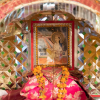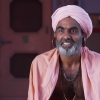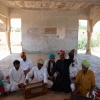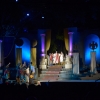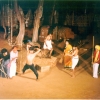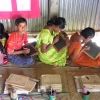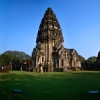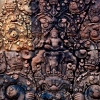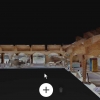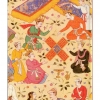Neerja Dasani: So I will start with, while going through some research that I was doing, I came across a quote of yours where you said, ‘In many ways I am the person I am because of that institution.’ So could you elaborate on that? We could begin with that.
V.P. Dhananjayan: Well, Kalakshetra is our alma mater and we have grown there— when I say we, both myself and my wife Shanta. We met in Kalakshetra as children, grew up together. But for Kalakshetra I would not have been landed in learning the art forms. Otherwise I would have been probably a politician, not [a] corrupt politician but a politician. Anyway, I happened to be there, it is just destined, destiny brought me to Kalakshetra. So Rukmini Devi Amma and Kalakshetra gave us all facilities free of charges. We were all scholarship scholars coming from a very, very poor family in remote Kerala. It is destiny which brought… And we were completely under Kalakshetra’s wing, taken care of, all our expenses, training, everything was in Kalakshetra. So naturally I owe everything to that institution specially Rukmini Devi, who was instrumental in giving us this opportunity.
We were all in Adyar Theosophical Campus when we were in the formative training period. Theosophical Society and Kalakshetra, they used to be very integral part of each other but …some rules and regulations that Theosophical Society put on Kalakshetra and they had to leave the campus in 1963. But while we were all in Kalakshetra in Adyar, Rukmini Devi started acquiring land in Thiruvanmiyur—the present Kalakshetra—and we were part of the developmental project.
All the students used to go and work there on weekends whenever we have holidays, we were to lay the roads, put the fences and grow the trees. The trees that you see today in Thiruvanmiyur campus are all planted by us, nurtured by us and grown by us. Everybody enjoys it now. So we are very proud that we are the real builders, brick by brick we have built Kalakshetra along with Rukmini Devi and a very dedicated band of staff members who had completely given their life to the growth of Kalakshetra without any consideration. Nothing, no criterion, they just worked for the institution, for Rukmini Devi. That is how she has been able to do this much.
Adyar was our home initially for almost ten years we were growing in Adyar Theosophical Campus. There the campus was reverberating with music and natyam, nothing else. We were confined to that atmosphere, a gurukulam atmosphere where all the teachers lived there and the teachers were all really enlightened souls. At that time there were not youngsters who were appointed but they were all part and parcel of Rukmini Devi’s Kalakshetra concept and her ideas. So they were all old people much above fifty, above sixty, above seventy and even great souls like Mysore Vasudevacharya who did all the music for the Ramayana series, he was almost 93 at that time. And my Kathakali asan, Guru Chandu Panicker who brought me to Kalakshetra was also in his 80s. So you can imagine the inspiration we had from the old people. And then our teachers—real teachers—means they completely dedicated themselves to only teaching. There were no other issues of money problems or housing problems or anything. They just lived there and taught and developed Kalakshetra repertoire. So that was the Kalakshetra in Adyar.
Then, we of course, as I said we built, our batch of students and staff built this Kalakshetra in Thiruvanmiyur and there we started being pupil teachers and also we imbibed a lot, great deal from those great masters who continued to come to the Thiruvanmiyur Kalakshetra and inspired all of us to emulate the values of life, the values of art. Kalakshetra is the one institution which made us what we are today. That is why I made that comment, nothing else. Because we are completely Kalakshetra. Today if there is a style of Kalakshetra, the style has been established with our group of students, our batch of students. Even Rukmini Devi experimented all her creativity on us.
What you see today in Kalakshetra is all built by us. We were the pioneers who invented… Kalakshetra style of Bharatanatyam is moulded on us. We were the people who propagated and established that style with of course Rukmini Devi’s vision. And she had her own very close confidantes like Sharda Hoffman, N.S.Jayalakshmi and all that. And they, when Rukmini Devi gives an idea, they chiselled, they were the architects or the shilpis who made us. So we were part of the whole development of the Kalakshetra style. Today we talk of the Kalakshetra style but the style was established with us, with our batch.
Again when I left Kalakshetra after almost twenty years and we were the first dancers to come out of Kalakshetra and started propagating the Kalakshetra style, that is myself and Shanta, because all the others, our contemporaries were still in Kalakshetra, within the four walls of Kalakshetra. They didn’t have much access to the outside, but when we left, we started doing the performances, Bharatanatyam performances as duo and we started propagating the style with its pristine purity. That is how Kalakshetra’s name started [spreading] wider and wider.
We are the people with the establishment of our own institution modelled after Kalakshetra, same way of [teaching], people used to say this is the mini Kalakshetra and that was the bigger Kalakshetra. So this mini Kalakshetra, that is Bharata Kalanjali started actually popularising Kalakshetra style of presentation because Kalakshetra at that time, they were confined to that campus. They never had much opportunity or Rukmini Devi did not believe to probably make more performances or anything. At that time it was more concentrating on developing the technique and people who want to see good dancing, they should come to Kalakshetra instead of Kalakshetra going out. But we were the other way, we wanted to, unless you go, it is [a] growing global situation, we have to go out and propagate it. So we did that with our bunch especially me and Shanta, took it more to the wider public because we were performing. Just developing a technique is not enough but we have to develop it. So through us Kalakshetra also had been projected. Directly or indirectly we contributed to the development of today’s Kalakshetra.
Rukmini Devi experimented all her creativity on us because we were the best batch of students at that time because she moulded and she was rightly active there, directly involved in our mould with the assistance from Sarada teacher and Jayalakshmi teacher. At that period when we were there for eighteen years she was able to create the maximum amount of dance dramas, all the Ramayana series were on us and before that Kumara Sambhavam, Kutrala Kuravanji and in between Gita Govindam and Kannapar Kuravanji. All those monumental productions that Rukmini Devi created were on us.
People still remember those days seeing me as Rama, I was throughout in Ramayana series, I was playing Rama’s role and later of course before I left I taught it to the next generations starting with [A.] Janardhanan. Now Janardhanan is also retired, he is much junior. He is also my Kathakali teacher Guru Chandu Panicker’s son. That is why when people talk about Rukmini Devi’s productions, they always remember us doing the main roles and also taking everything from her and helped her to embellish it because we were all trained, very well trained, at that time with stalwarts like Guru Chandu Panicker and many other great teachers both in music as well as dance.
And the atmosphere in Kalakshetra at that time was very congenial and gurukulam. Gurukulam means ‘family-like’. We used to live there like a family. There was no difference. Everybody ate, sahana vavatu, sahanau bhunaktu, the philosophy has been practiced very well there. Everybody ate together, everybody worked together, everybody had that camaraderie spirit. Maa vidvishavahai, no enmities towards each other because we are in a family; we [had] a lot of give and take. That was the kind of atmosphere we had in Kalakshetra at that time because all the stalwarts who are aged and also like grandfather-like, sage-like, such as Karaikudi Sambasiva Iyer who was the greatest Veena player, vainika; Mysore Vasudevachar, one of the greatest vaggeyakara like Thyagaraja, they were all living. At that time for us they were all living legends. Just if you want to see Thyagaraja, you have heard of Thyagaraja, but when you see Mysore Vasudevacharya, you can see how Thyagaraja would have been. So like Tansen or anybody like that. We have seen that.
We had the experience of interacting with them. And those people liberally gave. They never had any restriction. It is not like today’s world. You pay me and I give you. No, it was not like that. There was no payment, it was only giving. The art was being shared so liberally. So Kalakshetra became a monumental institution like Nalanda University. That was the atmosphere we were in.
The teachers also who had learnt from these stalwarts, they also shared their knowledge liberally with us irrespective of what subject was your main one. If I am [a] Kathakali student, I can learn Bharatanatyam, I can learn music, I can learn veena, I can learn violin or mridangam. I learnt mridangam and vocal music very liberally because there were no restrictions at that time.
Whatever you were interested [in], handle it, that is all. That is Rukmini Devi’s philosophy. There is no particular subject. Yes, if you have enrolled yourself as a Bharatanatyam student that will be the main subject. Maybe you will get certificate in that but you were able to learn other things also. It was a comprehensive education for us as rightly said by Natya Shastra: Na tath shilpam, na tath gnaanam, na saa vidya, na saa kala, na sow yogo, na tath karma, natyesmin yannadrushyathe (There is no other knowledge, no other sculpture, no other learning, no other art, not even yoga or action that is not found in dance. No wise utterance, no means to achieve learning, no art or craft is complete without dance.) In Natya you find everything. What? Engineering, architecture, mathematics, literature, yoga, everything is in Natya. So that was the kind of learning that we get. Everything comprehensive. I can talk about architecture today, it is because of Kalakshetra. I can talk about engineering, it is because of our learning, the systematic learning that we had in Kalakshetra at that time.
This is what Kalakshetra was. Now of course I can’t say anything, because we have come out and it is a government institution, things have changed, rules and regulations are implemented. I will say it is detrimental to the learning but still that is the way, we have to adapt to the modern world also. That is how it has been going on. But anyway we have so [many] nostalgic moments of Kalakshetra. It was a temple. It was a temple with all…doing the paricharaka karma [servant/assistant], the main deity was of course Rukmini Devi. We were all around her and we worshipped her because of her discipline and her concept of education which is character-moulding, through art the moulding of character.
As Tagore has said, “Education without character is body without head.” That was the concept Rukmini Devi had, education is there, but character moulding. So through the association of all these great people who [were] living examples to us, we emulated them. The character moulding was very essential. That is why our batch of students had a big, absolute camaraderie spirit like in Upanishad, Maa vidvishavahai—when you are in students’ community, you should not have enmity towards each other.
And Rukmini Devi, she explained and did that very well because when she choreographed, everybody learnt every patram, every character in a drama. Finally she will decide who will do what and sometimes maybe in the last minute, tomorrow is the programme, she will say, “Okay, Shanta, you are going to do Sita tomorrow” or she will say “No, Krishnaveni will do.” So we were all the time [on] tenterhooks waiting [to hear] what Athai is going to say tomorrow. Am I going to do Rama or a simple deer or a simple Brahmin? That was the kind of training. So everybody was so tensed, very dexterous…in the sense we knew everybody’s portions. So of course she has it in her vision, she has already decided who is suitable for each character; that is how it happened in those days. It doesn’t happen nowadays. It cannot happen nowadays because you don’t have….we have, as I always say, there is perspiration but no inspiration. Inspiration is very, very necessary, we had that.
I joined Kalakshetra at the age of 13 in 1953, and my wife Shanta was already there. She joined in 1952 as a young girl of eight in 1952. So she is one year senior to me though she was only eight years, I was thirteen. It was Rukmini Devi who asked Guru Chandu Panicker, the Kathakali Asan [teacher] to bring boys, especially she asked only for one boy, to learn Kathakali. At that time nobody came to learn Kathakali in Kalakshetra because Kalamandalam was already existing there, a lot of boys were being trained. But she wanted boys also here. At that time not many boys came forward to learn by paying a simple fees or anything. Fees were there, very nominal fees was there but still boys did not come there mostly because [of] parental pressure, because parents didn’t want boys to become a dancer. At that time that was the period when everybody wants to be a doctor or engineer or banker and all that. So boys were very limited and to get boys from any normal family is difficult. So she said in Kerala you may know some friends, bring some boys if they are interested. But those interested boys are all from the poor family where they cannot afford to have a family sustained. Mine for instance, my father was just an elementary school teacher who could not afford to…
It so happened, my father met Guru Chandu Panicker in the train and he asked Chandu Panicker whether he can take one of his boys. He was telling that I am selecting some boys, so father asked him, then he said, yes, yes, we want to have some boys. At that time Chandu Panicker had already selected one boy, that is Balagopal, my colleague but he told my father, I will take your son, one of your sons—four boys, there were eight in the family—but only if Rukmini Devi approves he can stay, otherwise I have to send him back. That was the condition. So naturally he came home to select one of the boys. He selected me, I don’t know why, just like that. So I was also happy at that time, to go to Madras is something great in the village and for a village boy. So I came with Asan Chandu Panicker and he told Amma, this is what happened, you can select whoever you want. So instead of selecting the already selected one, Balagopal, she opted to have me. But it was an embarrassment for Chandu Panicker Asan that he had already selected the other one through the proper application and all that. Then I think something happened and Sankara Menon was there at that time, he said, okay, let us keep both because they were all under pressure, economic pressure because they did not have much money in Kalakshetra at that time to keep two boys. It was expensive to have too many unpaid students. If they are paying students, then no problem.
Anyway as luck would have it I was also selected and there was some premonition at that time when Asan took me and Balagopalan when we arrived here to her house, Rukmini Devi seeing three of us walking, something has struck her, she called out to Sankara Menon and said, she who is coming, Viswamitra, Rama, Lakshmana. At that time she was planning to have Sita Swayamvaram production. That is how Mysore Vasudevacharyar was there composing music. Then later on the conversation was hot and finally they decided to have. Then finally she cast us as Rama, Lakshmana. Such was her first prediction, just blurted out like that seeing an old man like Viswamitra Rishi and two boys walking behind him, it looked like Rama and Lakshmana. So we were Rama-Lakshmana for a long time in the productions.
Training was so intensive and there was no time limit at that time because the old acharyas, they don’t have their own academic timings. They taught us according to their whims and fancies. Sometimes there will not be anything, sometimes there will be a long class, sometimes it will be at midnight because we were living with them. So according to their mood. They also go through the…human age, they are also aging, so according to their willingness we had classes especially Kathakali class. But Bharatanatyam class always we had simultaneously and in the evenings when we don’t have Kathakali, we also had Bharatanatyam because Rukmini Devi wanted us to learn both simultaneously so that in her productions it will be useful. So that is how she choreographed all her major pieces on us because we had been already groomed into Bharatanatyam also.
And Kathakali as a technique; Rukmini Devi liked Kathakali technique because it is very profound and very demanding; and histrionically to get good expressions, stylized expressions, not casual expressions. In those days in Bharatanatyam it was very casual expressions, not technical expressions but she wanted technical expressions, use the eyes and movements because she has learnt from the Natya Shastra. Shastra is very, very scientific where somewhere in the history, the scientific process of learning of Bharatanatyam was lost. She realised it when seeing Kathakali training. And Kathakali was still retaining that technique and especially Asan, who was an old man who has gone through the olden days training. She believed in it and she wanted everybody to learn Kathakali, even those people, Bharatanatyam people, she wanted because it develops your muscles and you can have highly technical and classical expression.
At that time some people, the dance critics, criticised her saying that she is mixing Kathakali with Bharatanatyam. She has faced them. She didn’t care about all those things. She said what is good has to be retained, that is what I want. Whatever critics say, I am not going to take because Kathakali technique is very, very good especially for the expressions. That is why in Kalakshetra the expression part of it, very stylized expressions. We don’t do casual expressions. They say ‘natural’. There is no naturality in art. Art is definitely an exaggerated medium. It is not natural. Art is something very…it is not just photography, it is like creating a painting. We have to be little artificial. So when your exaggerated expressions are there it accentuates your emotions, which can communicate to the audience easily, not superficially. We should go deeper into the rasikas. It is not superficial.
At that time usually the devadasis, they did very superficial abhinayas. Even today we see some people doing superficial abhinaya which has no depth whereas Kalakshetra abhinaya…and people who criticised Kalakshetra abhinaya is Kathakali abhinaya, they also, many people have accepted it saying, yes, there is something very classified acceptance of Kalakshetra abhinayam because it is stylized. We don’t just move eyes like that but technically we move. We exercise the anga-pratyanga-upangai, all the finer limbs of the face, we use [them] correctly to suit that particular bhava abhinaya [emotional expression]. So that is why it is more profound than anybody who is doing casual abhinayas.
There has been a lot of discussion going on about that. Even today some people think Kalakshetra doesn’t have, but we have all survived with our abhinaya. Nobody says that we lack abhinaya. Some people still criticise and say that they need some other, the lighter, ‘light abhinayas’, which they think they can communicate to the ordinary level of people. But our technique is not just for ordinary, we have to elevate people to our plane. Educate, elevate and entertain, there are three levels. So we educate them with proper technique and then elevate them to a level where they can enjoy these histrionics. And then automatically you get entertained. These are the three levels. Kalakshetra technique has been very, very ideal for any performing art. So they established that and to establish that Rukmini Devi got help from Samskritam scholars who interpreted Natya Shastra and connected text very correctly and it has been passed on to the teachers and students. We were all part of that period where the theoretical study of Natya has been enhanced in Kalakshetra. Till then outside Kalakshetra there was no theory taught. Even the greatest of gurus, they never taught theory. Kalakshetra revived it and when we came out of Kalakshetra, we started propagating it to others. Everybody started learning it. That is how today the standard of Bharatanatyam has been to a certain extent standardised whether it is Kalakshetra style or…we say only two styles, good and bad.
If you are well following that technique, very well, then it is good and somebody who doesn’t follow that profound technique, it becomes bad. But today because of Kalakshetra’s influence, Kalakshetra’s technique, everybody has improved. So Kalakshetra’s contribution is much, much great in this century actually. People should accept it. There is some school of thought, they won’t accept it but it is the truth. It is a naked truth; Kalakshetra has influenced not only the Bharatanatyam technique or Kathakali technique throughout Bharata Desham it has influenced, even the people who are for Odissi or Kathak or Yakshagana, everybody has improved their presentation standard. The example was Kalakshetra, definitely. So it stands as a monumental institution for the entire Bharatam.
…teacher living there and teaching all throughout the day and night, there was no specific time. In Kalakshetra at that time we had that timing structure but we didn’t follow it because of the old…the acharyas were like that. But there are other sections like if we have an English class… one beautiful thing in Kalakshetra is they gave a complete common education also, English education also—where we had classes on geography, mathematics and all the language[s]. Language was a must. Samskritam was compulsory and Tamil was a great asset because we had Tamil scholars at that time. Even Rukmini Devi revived the Tamil literature; Tamil scholar, U.V.Swaminatha Iyer Library she started actually bringing all the Tamil literature back into publication and all that.
Anyway Tamil was also part of our curriculum. So within the time limit we had, everything was available. We had Tamil classes, Sanskrit classes, English classes—Sankara Menon used to take Shakespeare, Keats, Shelley, all these poets. He used to come early in the morning because we were all inside and so there was no time limit. We can get up… we all used to get up at 4 o’clock and have the whole entire time at our disposal. So teachers will call. Sankara Menon was Athai’s, Rukmini Devi’s right hand, so he would come at 7 o’clock and say, come I am going to take Shakespeare today, and evenings sometimes after the class, he would say I am going to have Gita class. He was a great scholar. Everything was on his fingertips. He was a great inspiration for all of us, the greatest educationist I should say.
So that kind of education it was. And also every week people from different walks of life— doctors, literary people, politicians, government administrators, they come to Kalakshetra and talk to the students. We have imbibed a lot from them. C.P. Ramaswamy Iyer talking about the national integration through linking the rivers, all his subject. Even today if you see couple of my publications, I have quoted all this and I write about the politicians and the administrators, how good it will be to have all the rivers, linking of Cauvery with Ganga or Ganga with Cauvery, how beautifully it would work. How C.P. Ramaswamy Iyer used to say, the best thing to happen for Bharatam is to link both so that we will never have any problems, no water problems, no regional problems, everything will be solved. We will be an integrated Bharat Desha, a united India. That is what he used to tell us.
So I have taken all that and I use it for my lectures to the youngsters and my books. So we were able to listen to great, great, great people at that time including Nehru, Rajendra Prasad. When they talk, we are thee right in front of them sitting and watching them. C.P. Ramaswamy Iyer and C. Rajagopalachari, who was the Governor-General of India at that time, used to visit Kalakshetra very often. And Kamaraj, a simple person who was walking into the class and watching our class. A great lady like M.S. Subbulakshmi just walking into a concert and sitting in front of us, we are performing in front of such… That was the atmosphere of Kalakshetra and that is how we learnt our lessons, not literally by class or anything but literally by living with the legends.
That is what Kalakshetra should have retained. Unfortunately with the government interference and a lot of money coming, everything has gone, watered down. But at that time we never had money but the vidya sampat dhanam—vidya dhanam sarvadhanal pradhanam [The wealth of education is more important than all other wealth]—vidhya dhanam, that dhanam was there. So we were able to assimilate so many things. That generation of students have got much from Kalakshetra. That was the kind of training we had in Kalakshetra—unrestricted, undiluted education and character building. Everybody had [a] good nature. Even today our generation of students who are all over the world, we have so much of relationship today. We have never severed our relations. We meet, whenever we meet after…for instance, just two days ago I met a person, one of our classmates after fifty years. We were able to recognize each other and remember the name, out of all many students. So that was the kind of relations, just like family. In a family it is like that. So that was the atmosphere.
And as I said time restrictions were not there. Early morning we start and the teachers will irrespective of their subject, they will involve [themselves] in the other subject also and there were no people saying “Why are you indulging in my subject? I am their music teacher, why should she come and say something in the Bharatanatyam class or in the Kathakali class?” That was not there. Anybody can walk in to correct us. For instance, when we used to practice, we have a practice mirror cottage, they call it mirror cottage in Adyar and the vainika, Karaikudi Sambasivam in his 80s, he was just living in a small, the street-like houses in Theosophical Society, he would get up, they are all old people, get up very early. When we would practice, he would walk in and say there is something wrong going on in your step, a taalam. He will come and correct it at that time in the early morning listening to the beat of our feet, he would say there is something wrong going on and so he would come and beat his vethalai pakku, the paan [betelnut leaf with areca nut] he [would] always have daily, he would smash it and eat it, the old people must be remembering that. So he would just hold the taalam properly, ask us to…but it is not his subject, but he has interest in the students. And I can walk in to Vasudevacharya’s cottage, he was a very great person, and he would sit down and sing this song. We are not music students, we are in the Kathakali class, but involvement of all the others, they very, very cordial and very inspiring for all of us.
And there is no restrictions, Rukmini Devi or administration will not say, “Why did you go to his class, why did you go?” There is no such thing. “Yes, did you go, what did you learn from?”, that is the question people will ask. And we can walk in to Srinivasulu, the greatest painter and he will be keeping all his painting brush, everything in the class and he would just say, “Vaa da, come here, there is the canvas, put something there, draw something there.” And he would just do like, from that we have learnt the colouring system and he used to design Rukmini Devi’s costume and head gears, he used to design and we used to make it.
Those days we never hired anything from outside. Now everything is available outside but that time in Kalakshetra every dance drama, crowns and costumes we made, so we were able to learn that art also. The crowns, the jewellery and with simple materials. No cost. With jutes we used to make ornaments; that is the idea of Srinivasulu, [he] was a great artist. And painted with gold, then it looks like very great gold. And people will say, “Oh! Such a beautiful ornaments.” It was all made by us. I think it is still there what we made but nowadays of course there are people who are specially employed to make it. But students are not able to partake in that. We were able to do it. So that is the training. It was a comprehensive training. Everything involved. So that is why I think we are miles apart from the today’s generation of students because we can talk on many things, we can really train everybody.
See, we came out, we were after eighteen years, I came here after eighteen years but Shanta came after twenty years—she was still working after I left—but we were fully prepared to start an institution and train ourselves. We didn’t want somebody else to—at the Kalakshetra there were many people but for us we were only two of us—we were able to train musicians, we were able to train the dancers, we were able to train mridangists, accompanists, able to train costume makers. Many costume makers today you find in very lucrative careers, they are all trained by us. I can proudly say many of them who are existing today as Bharatanatyam costume makers, it was we who gave them the ideas. Of course every inspiration came from Rukmini Devi but we also evolved ourselves as costume designers. After Bharata Kalanjali established, when we started producing our dance-dramas and our students, we changed the costumes, we designed our own and some of them [have] become very popular through the tailors that we have trained, given them the ideas and made them to do. So that we are able to do because of the comprehensive training that we got in Kalakshetra and that is not…today I don’t think the students have that kind of profound, deep studies.
The music side of Kalakshetra, as I said we had the greatest of musicians living in Kalakshetra starting from Tiger Varadacharya and Papanasam Sivan and Mysore Vasudevachar and Veena Karaikudi Sambasiva Iyer and M.D. Ramanathan, all those legends were in Kalakshetra. So Kalakshetra was fully reverberating with music. And in Adyar when we were all there, those legends were living there, people can hear music every, the peaceful music refrains coming from the forest because there is a garden, Theosophical garden. So music was with the atmosphere completely.
As students the syllabus had compulsory music classes. Every student should have music and language. It was very compulsory. But our majoring will be in Bharatanatyam or Kathakali but music was an integral part of our training. So even if you have the flavour for it or not we will definitely have to sit in the music class and then learn. That is why we have, both Shanta…Shanta had actually really learnt a lot. As far as I am concerned, I had only limited number of years, classes of music, because we were concentrating more on Kathakali and then Bharatanatyam, but Shanta had longer period of music class and she sings much…even [a] concert she can conduct. So now she is able to train all our musicians singing…correct music she can give.
So as we have the liberal freedom of handling anything in Kalakshetra, everybody who has walked into Kalakshetra will have a musical background. they can enjoy the music and the biggest advantage because of the dance-dramas, the music composers…they composed…we also got the training to compose because they composed dance-dramas and [those] compositions consist of the raga-bhavas. We learnt, when we are learning it we understand which ragas suits for the kind of abhinaya. That was also part of our training, musical training.
So the people who are trained in Kalakshetra with the background of raga-bhava and also Sahityam, Samskritam, everybody learnt Samskritam. So in Kalakshetra, rendering of any language of the song, they pronounce it correctly and we have the people to correct it especially we had a teacher in our time, Sarada Teacher, S.Sarada. There were two Saradas, big Sarada and small Sarada. Small Sarada is Sarada Hoffman who trained us physically but spiritually and the literary side is the Big [Periya] Sarada who was a great scholar of Samskritam, Tamil and music. She used to talk to us, she used to give us all the nuances of ragas and raga constructions and the taala constructions and how it is used in the abhinaya patterns. Whenever she used to explain why such and such a song is set in such and such a raga, what is the beauty about it and how you have to involve, you have to internalize or you have to learn to imbibe the musicality first and then try to express it. So knowing the music, it is very easy to express. That is the kind of musical training we had because to get that you have to also involve [yourself], otherwise you cannot get it. The student should get interested in learning it. If you don’t have the interest, you will lose. But at that time probably we were not looking at getting a diploma or degree. We were not trained for it.
Nowadays of course they have to finish everything in four years and go and start getting their employment and getting money. When we were there it was not like that. We never had any idea of what is certificate, what is diploma? After twelve years Rukmini Devi called and said, ‘Hey, we are going to give you a diploma.’ What is diploma? At that time that is the kind of ignorance. But we just learnt learnt, learnt, learnt, learnt, that is all. Then suddenly they said they are going to give you a diploma. Okay. Diploma is there. Then after two years, we are going to give you Post-graduate diploma. We didn’t know what was it actually. Then we got both and both are in the file. I have not shown it to anybody. It is there. But the merit, the training that we got, we have been carrying on. So musically, Kalakshetra insisted that everybody learning natyam should learn music.
Then [the] male aspect…Rukmini Devi believed that all her characters in the dance-drama should be portrayed, male portrayal should be by men dancers. There was a time when there were no male dancers in the Bharatanatyam style, so females used to adorn the male attire, male character and then perform which was a little incongruent actually speaking. And it looked very, very artificial also. The female doing a male role. They can do it but still there was something wrong which Athai [Rukmini Devi] said no, we want a male. And training also, at that time unfortunately, the male students who started learning Bharatanatyam were made to look effeminate. That was a taboo. That is why most of the parents did not want male dancers to learn dance. They thought, there was a wrong notion that if you learn Bharatanatyam, you become effeminate. And there were many examples like that. So she wanted to change that trend, so she trained all of us manly, man should dance like man, no effeminate things.
At that time this Kathakali training was very, very handy. That is why she envisaged that everybody should learn all men dancers should learn Kathakali and the Kathakali exercise, the Kalaripayattu and also massage and all that. We had all that intensive and a very strong base of male-oriented training. So our characters, all Kalakshetra dancers, male dancers, you will see they dance like man and outside if you see some of them did not have that kind of, you still have a trace of some femininity in them that makes the public feel that there is something wrong with that boy. Now of course I must say there is a lot of improvement thanks again to Kalakshetra and as a male Bharatanatyam dancer I think I was the one who really came out from Kalakshetra and shown to the other people that a man can dance like a man, Bharatanatyam especially.
Initially when I used to dance, people used to criticize. There were critics saying ‘Oh, he is a Kathakali dancer that is why he is doing like that.’ But over the years people understood a man should dance like a man and what Dhananjayan is doing is right though there is a technique, Kathakali technique, which is good even to complement the Bharatanatyam. Now there are a lot of Bharatanatyam male dancers, I should say credit must go to me, go to Dhananjayan because I showed them how man could exist like man dancers. Not very many male dancers were at that time including Ram Gopal and all that, they had some feminine aspect but they did not sustain, they did not do Bharatanatyam, full Bharatanatyam as Margam [solo repertoire] as I did.
I was the first person I should say that along with Shanta and also as a solo Bharatanatyam artist, in the other styles you will have a lot of male dancers doing solo like in Kathak and all that but in Bharatanatyam at that time, the 50s, 60s, 70s, not male Bharatanatyam dancers. I stood out as an example and I boldly stuck on to the Margam pattern and stick on to Kalakshetra style and showed people that we can successfully perform a Bharatanatyam repertoire. It is not a feminine world anymore. It is not only for girls. So that way certain example I set apart and now we have very, very good men dancers in Bharatanatyam. So that again, the credit goes to Kalakshetra. Definitely Athai’s vision, she wanted us to be like that and she wanted others also to dance like men, man dance like man. That spirit and ideology that she established has now been popularized through our dancing.
Especially Dhananjayan in the 60s and 70s and 80s, I struck the stage especially in south India. Then again I was in the north, I was travelling a lot at that time, so people know me a lot in the northern area as a Bharatanatyam male dancer. There also they had a problem in the north, naach was not accepted for men and if the Kathak dancers come, they were not treated very favourably. They always had a secondary but things have changed now. They respect. If a man dances like man, they respect that person. But if they do effeminate, then they don’t. They think demean…so everybody wants to have that respect, dance like a man and that is how it has evolved. Now today we are happy a lot of male dancers are there in the scene.
Having said all that, we give the credit to our alma mater Kalakshetra. That is the best training anybody can get and even today the training system that Rukmini Devi has established in Kalakshetra is the best system and universally accepted system. People ask for Kalakshetra style but I always say, as Rukmini Devi quoted, there are only two styles of Bharatanatyam and that is good and bad. Kalakshetra still retained the good method of training, good dancing. Even today I think the children are doing very well. So Kalakshetra is the central base for the Bharatanatyam standard that has been established throughout the world. Everybody wants the Kalakshetra style. It is a good style. Everybody accepted it is a good style, that is all I can say.
(V.P. Dhananjayan was brought to Kalakshetra at the age of 13 by the famed Guru T.K. Chandu Panikkar. Today he runs his own dance institution, Bharata Kalanjali, along with his wife Shanta Dhananjayan.)



